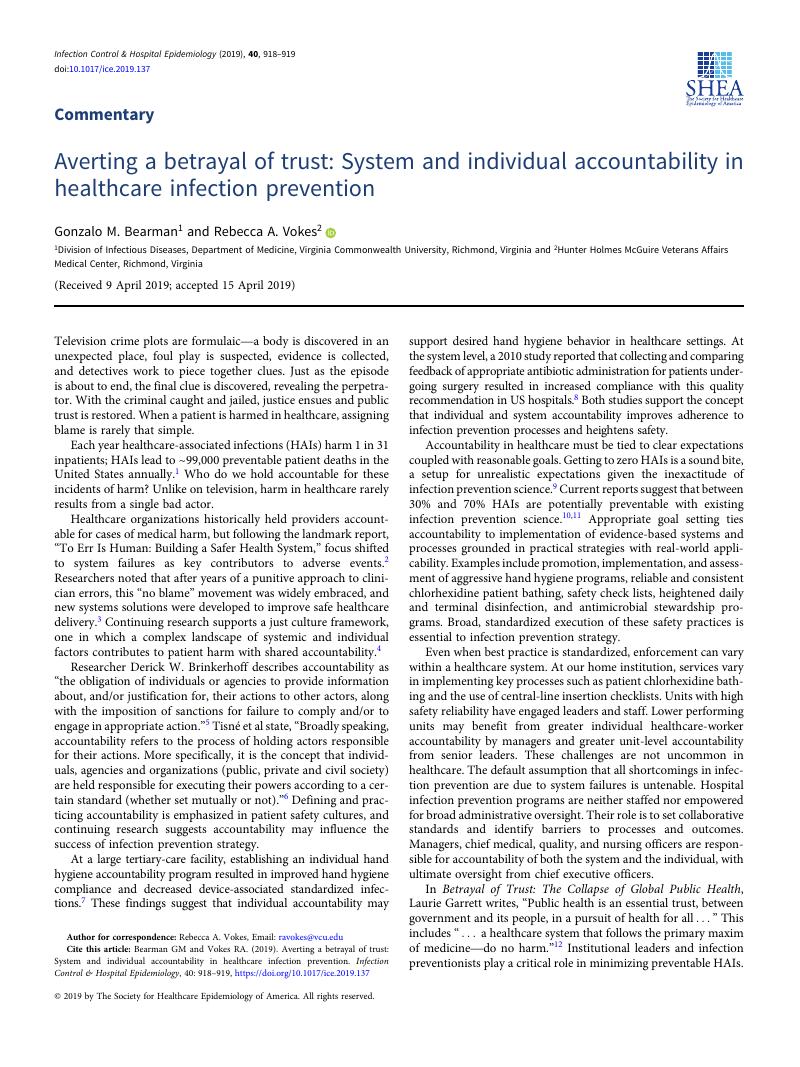Crossref Citations
This article has been cited by the following publications. This list is generated based on data provided by
Crossref.
Bearman, Gonzalo
Hota, Susy S.
and
Haessler, Sarah D.
2019.
Physician burnout and healthcare epidemiology: Dual implications worthy of greater scrutiny.
Infection Control & Hospital Epidemiology,
p.
1.
Bearman, Gonzalo
Pryor, Rachel
Albert, Heather
Brath, Lisa
Britton, Amy
Cooper, Kaila
Doll, Michelle
Godbout, Emily J
Hemphill, Robin
and
Stevens, Michael P
2020.
Novel coronavirus and hospital infection prevention: Preparing for the impromptu speech.
Infection Control & Hospital Epidemiology,
Vol. 41,
Issue. 5,
p.
592.
Hess, Olivia C.R.
Srivastava, Meha
Pryor, Rachel
Patrick, Amie
Cooper, Kaila
Godbout, Emily
Anderson, Katie
Doll, Michelle
Stevens, Michael P.
Hemphill, Robin
Edmond, Michael
Wenzel, Richard
and
Bearman, Gonzalo
2020.
The learning hospital: From theory to practice in a hospital infection prevention program.
Infection Control & Hospital Epidemiology,
Vol. 41,
Issue. 1,
p.
86.
Hossain, Md Kamal
and
Thakur, Vikas
2020.
Benchmarking health-care supply chain by implementing Industry 4.0: a fuzzy-AHP-DEMATEL approach.
Benchmarking: An International Journal,
Vol. 28,
Issue. 2,
p.
556.
Bearman, Gonzalo
and
Nori, Priya
2023.
Implementing behavior change in healthcare epidemiology and antimicrobial stewardship: The worst that can happen is you fail.
Antimicrobial Stewardship & Healthcare Epidemiology,
Vol. 3,
Issue. 1,
Agarwal, Suman
and
Singh, Ranjit
2023.
Customers’ Perception Towards Accountability of Diagnostic Centres: Evidence from India.
Journal of Multidisciplinary Healthcare,
Vol. Volume 16,
Issue. ,
p.
2947.
Bearman, Gonzalo
2023.
Leadership in healthcare epidemiology, antimicrobial stewardship, and medicine: A soccer enthusiast’s perspective.
Infection Control & Hospital Epidemiology,
Vol. 44,
Issue. 2,
p.
171.
Pryor, Rachel
Veeramasu, Yashasvisai
and
Bearman, Gonzalo
2023.
Infection Prevention in Remote or Resource-Limited Settings: Deploying Technology While Preserving the Human Touch.
Current Infectious Disease Reports,
Vol. 25,
Issue. 11,
p.
225.



